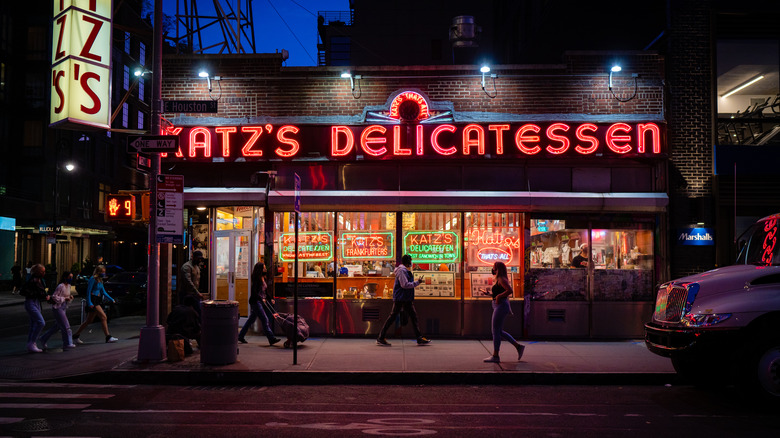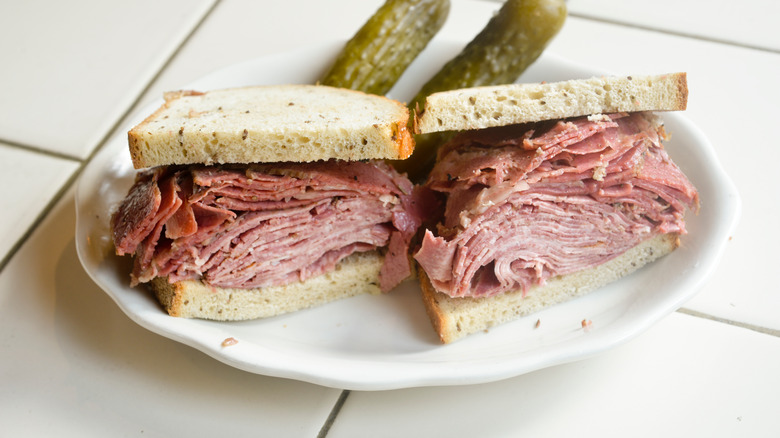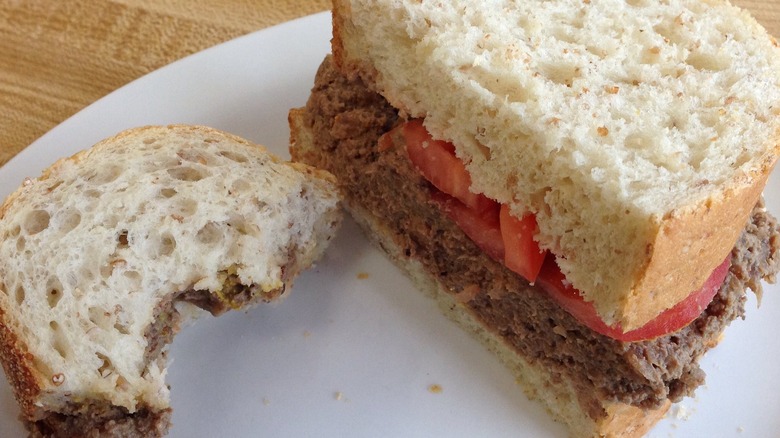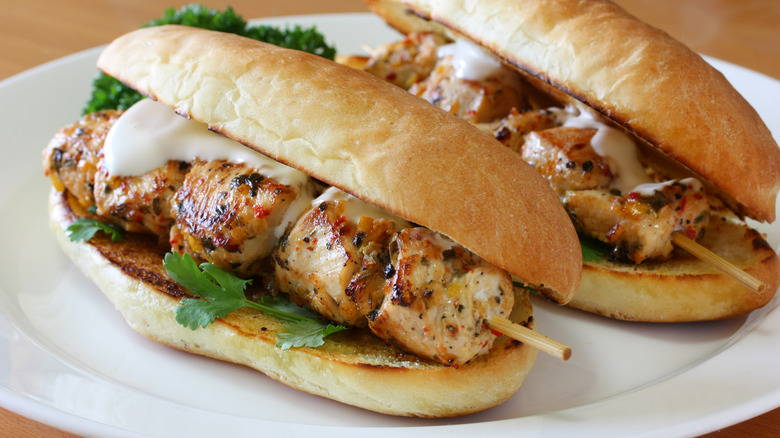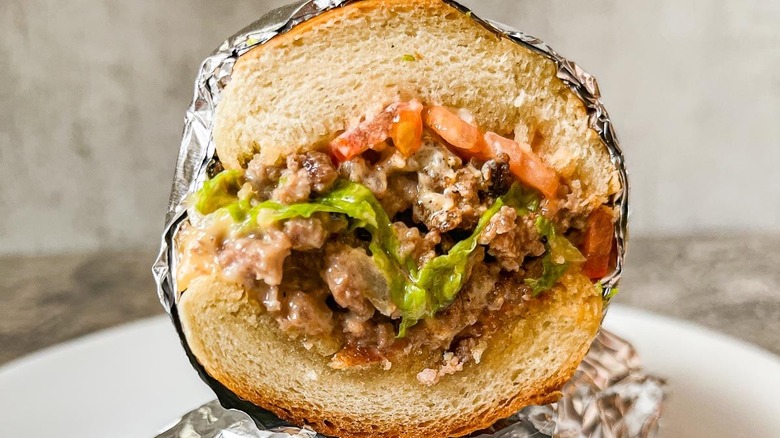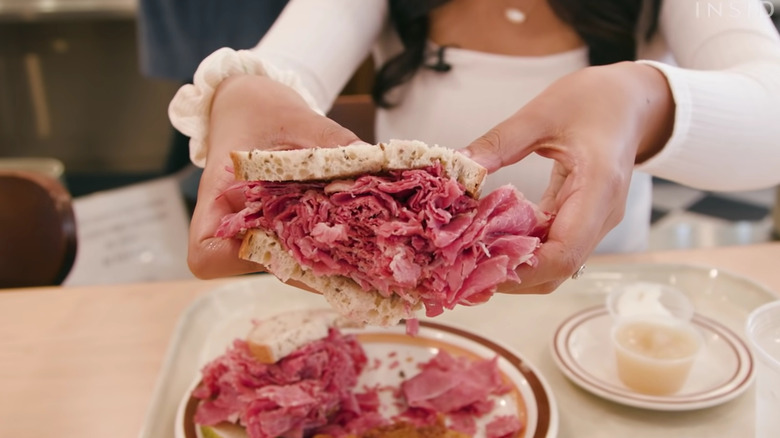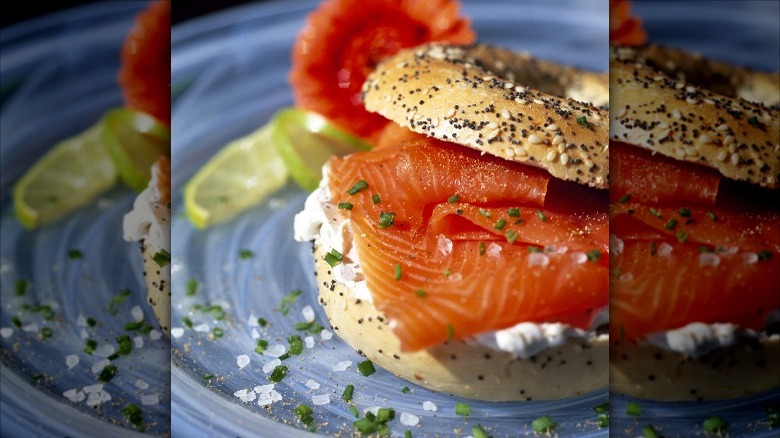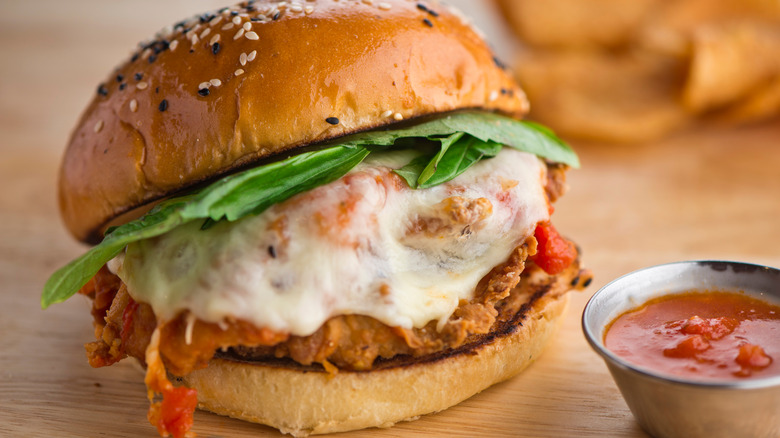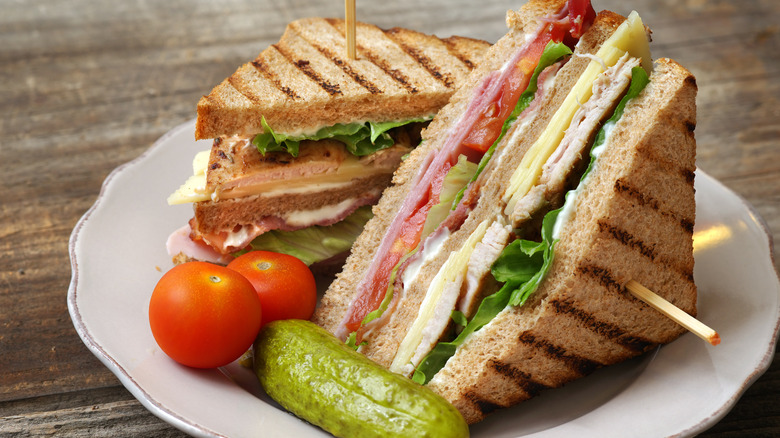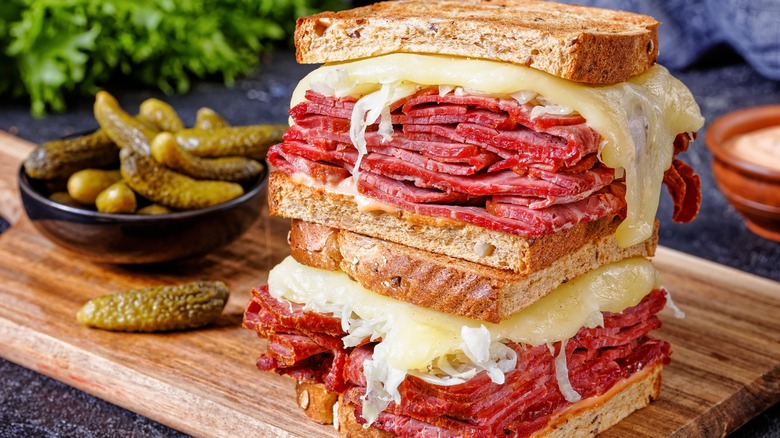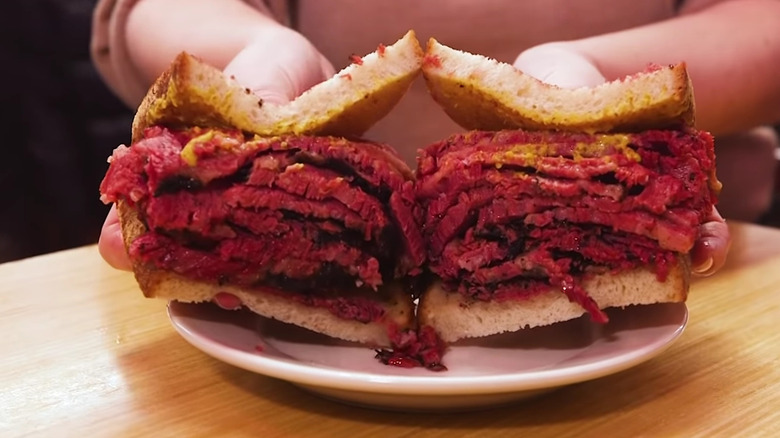New York's Most Famous Deli Sandwiches, Ranked
Like so many things in the state, the delicatessen is an immigrant experience that has been fully adopted by New York. While having its origins in central Europe (via Untapped Cities), the type of delicatessen (or deli) for which New York became famous began opening up in the state during the latter part of the 19th century as European Jewish immigrants began moving to America's east coast to try to escape rising levels of antisemitism and subsequent persecution (via Library of Congress).
As immigrant numbers swelled, so did the number of delis. One estimate highlighted by the BBC suggests that, prior to World War Two, there were anywhere between 3,000 to 4,000 delis in New York City alone. Unfortunately, an increasingly health-conscious population and soaring costs have seen this number dwindle to under two dozen.
Among those still standing is the iconic Katz's Delicatessen. Here traditional, Jewish delicatessen fare has been enjoyed for over 120 years, including Matzoh ball soups, latkes, and of course, several famous sandwiches (per Katz's Delicatessen).
The number and quality of sandwiches served within New York delicatessens such as Katz's are legendary. And while there are plenty of newer establishments innovating in order to seek a new audience, the appeal of classic deli sandwiches remains. Read on to discover the most famous bread-entombed creations from this illustrious part of New York's culinary history.
12. Beef tongue
Tongue, most usually from a cow, has an extremely long history in Jewish cuisine — a fact attested to by Talmudic commentary that Abraham served tongue slathered with mustard to three angels in Genesis 18 of the Hebrew Bible, per Tablet. However, the tongue's religious and culinary significance does not stop there. According to The New York Times, tongue is frequently served at two of Judaism's biggest holidays, Rosh Hashanah and Passover.
Given the prevalence of tongue in Jewish cuisine, it should come as little surprise that the meat used to feature prominently in the sandwich menus of New York's most famous delicatessens, per The New York Times. Many of those that are still open do, with the indomitable Katz's Delicatessen being the most highly rated purveyor of tongue sandwiches, according to Yelp.
Those that choose to buy this delicacy will most likely receive a choice of center or tip cut, per Katz's Delicatessen. While the former is the fatter and more flavorful of the two (via The New York Times), both offer a rich, meaty taste and luscious texture imparted by the fat which runs throughout the muscle (via Fine Dining Lovers).
Unfortunately, many people will avoid ordering this incredibly flavorful sandwich for a number of reasons. One is that Western diners are becoming increasingly averse to offal (internal organs), as a study by the British Government highlighted (via Food Navigator). As such, it comes in as the lowest sandwich on our ranking.
11. Chopped liver
Another delicious, traditional New York delicatessen sandwich filling is chopped liver. According to Sarge's — one of New York's most beloved Jewish delis — chicken livers have long been a part of Eastern European Jewish cuisine. When individuals from this culture immigrated to the United States, chopped liver came with them, becoming a staple of Jewish delicatessens, per Contexts.
When served in a sandwich, chopped liver can range in texture (via The Washington Post). The mixture can be made richer through the addition of schmaltz (per Saveur) and frequently can be blended with a number of accompaniments including onion, eggs, and even chickpeas, according to The Washington Post.
As highlighted by Livestrong, just about all animal livers contain significant amounts of cholesterol and, when not eaten in moderation, their ingestion can increase a person's risk of heart disease. In order to cater to those who would rather go without liver — whether due to medical reasons or not — but still want the taste, some delis are starting to offer vegetarian chopped liver. This is part of a wider trend of plant-based Jewish delis, according to Vegetarian Times, although it remains to be seen whether this sandwich filling becomes as popular as the original.
10. Spiedie
It is a rare occasion that one needs to step out of New York City in order to taste a famous sandwich, so prominent are the city's delis. But, when it comes to the spiedie — a simple sandwich made from marinated and grilled meat served on a roll (via What's Cooking America) — this is exactly what one must do.
Located in upstate New York, the town of Binghamton is responsible for the spiedie's invention. More specifically, the honor of the spiedie's invention goes to two Italian American brothers, Camillo and Augustino Iacovelli, who first created the spiedie in the 1930s, according to Vice.
Due to the sandwich's simplicity, the key to a great spiedie is all in the marinade. This led two local leading delis — Lupo's and Salamida's — to create, bottle, and sell their own spiedie sauce. This fact has been a continual source of division in the local community, as highlighted by Paul Van Savage, a food historian: "Some people will only use the Salamida's, and some people will only use the Lupo's. But the choice of bottled sauce has replaced the family recipe" (via Vice).
But while there are disagreements on which marinade is better, one thing is for certain; to get a great spiedie you have to visit Binghamton.
9. Chopped cheese
A lot of New York's most famous sandwiches originated in delicatessens in New York City's Lower East Side. However, other parts of the city can also claim more than a few notable sandwiches of their own. Chief amongst these is the chopped cheese — a mixture of ground beef, onions, and melted cheese — which is served on a hero roll (per The New York Times). Thought to have originated in Blue Sky Deli, East Harlem, this sandwich has received national coverage thanks to its inclusion in hip-hop music, debates surrounding the gentrification of food, and of course, its delicious flavor.
While the chopped cheese was initially a local specialty, the cat is now well and truly out of the bag. Now, versions of the sandwich can be found throughout the city from the Meat Hook Sandwich Shop in Brooklyn (via The New York Times) to Olympia's Finest Deli in Manhattan (via Yelp).
A key part of the chopped cheese's attraction is its unpretentious — and undeniable — flavors. When mixed with the pride New Yorkers take in their own, it has become a must-try for many in the city as explained by Harlem rapper, Bodega Bamz: "It's not like a Wolfgang Puck dish. There's not some secret ingredient, like, 'Oh my god, where did you get the beef from, Poland?' But it's a piece of culture that New York only has. It's for us" (via First We Feast).
8. Veal parm
Having been served in Italy in one form or another since the first half of the 18th century (per La Cucina Italiana), parmigiana is a dish that has immense staying power. It's not difficult to see why. Layers of eggplant, chicken, or veal smothered in tomato sauce and served with lashings of melted cheese are always going to be popular.
Of course, parmigiana found a whole new audience when it was brought from Italy to the United States by Italian immigrants, who arrived mostly during the late 19th and early 20th centuries, as per the Library of Congress. According to The New York Times, the affordability and availability of meat in the United States led Italian Americans to create more parmigiana with meat products, especially the highly touted veal (via Eater New York).
Pinpointing the exact moment when one entrepreneurial individual decided to make a veal parmigiana sandwich is impossible. However, the sandwich was famous enough by the 1980s for Burger King to launch its own version, much to the dismay of animal rights activists (per The Christian Science Monitor).
Fortunately, the veal parmigiana that is now available in New York is far superior to the one that was served at Burger King forty years ago. As Eater New York highlights, some establishments, such as Faicco's Salumeria, pay homage to the long history of veal parm sandwiches by producing a sandwich filled with generous, thick, and high-quality cuts of veal.
7. Bacon, egg, cheese roll
Synonymous with New York City's bodegas, the bacon, egg, and cheese roll has become a stalwart of both delicatessens and specialist sandwich shops (via Time Out). This is probably attributable to the sandwich's incredibly wide fan base, as highlighted by bodega owner Francisco Marte: "Bacon, egg and cheese — you can't take that sandwich away. That's the favorite sandwich for the New Yorkers" (via AP News).
The chosen breakfast of people in the city, the bacon, egg, and cheese roll has gained acclaim largely due to its accessibility and portability, according to AP News. However, with a little attention to detail, this simple sandwich can be elevated into something worth more than the sum of its parts.
For example, Sarge's Delicatessen makes a perfectly executed bacon, egg, and cheese, according to Time Out. Meanwhile, BEC, a sandwich shop specializing in the roll, briefly transformed it into an entire business model (via The Infatuation), albeit to the dismay of some New Yorkers who bemoaned the gentrification of yet another iconic sandwich (per The New York Times).
6. Corned beef sandwich
As Smithsonian Magazine reports, corned beef as a product has been popular since the 17th century when beef was cured in Ireland using high-quality, large grain salt. Since this time, corned beef has become part of a well-known American St. Patrick's Day meal, although it is not one that is enjoyed back in Ireland (via Irish Central). Outside of St. Patrick's Day, corned beef has also made a name for itself as a top quality sandwich filling.
While associated with Irish immigrants, corned beef sandwiches actually mark the intersection between Irish and Jewish cuisine which occurred on American soil as far back as the 1800s, per Time Out. Today, corned beef sandwiches are available in New York's most noted delicatessens including Sarge's and Katz's. The sandwiches served here are made from a type of kosher corned beef (per Smithsonian Magazine). Some of these delis, such as Katz's, use a 30-day cure (per Time Out), resulting in a sandwich stacked tall with slices of extremely tender and flavorsome meat.
5. Lox bagel
One of the earliest written records of a bagel came from Poland in the early 17th century, although it is thought the bread could have been around in Eastern Europe for much longer than that (per Smithsonian Magazine). When the bagel made the journey over to the United States, it quickly became associated with Jewish delicatessens, although the bagels themselves were usually made in small Jewish bakeries, predominantly situated in the Lower East Side of New York (via Untapped Cities).
Despite the prevalence of bagels throughout the 20th century, the bread reached more widespread prominence during the 1960s and 1970s, notes Smithsonian Magazine. Since this time, bagels have grown to be an indelible part of New York's culture while also forming the base for some excellent sandwiches along the way.
Perhaps the most famous of all bagel sandwiches is the lox bagel. A Jewish specialty, lox bagels are usually made by combining a bagel, cream cheese, and smoked salmon, although a more traditional take on lox is thickly sliced, salt-preserved salmon (via Daily Maverick). Today, most New Yorkers opt for the more modern, lightly smoked salmon.
Either way, the sandwich is a much-lauded invention, as highlighted by journalist Heather Smith: "The cronut and ramen burger — those were also invented in New York. But in those cases, you can trace it back to a specific person. In this case, it seems to have just sprung like Venus from the clamshell. The bagel [and lox] may just be our greatest triumph" (via NPR).
4. Chicken parm
While veal parm sandwiches undoubtedly have a special place in many customers' hearts and stomachs, it is the chicken parm that reigns supreme. This is despite the fact you would never find anything of the sort back in Italy.
Chef Michael White explained to Thrillist: "You will only find eggplant Parmigiana in Italy, it's never made with veal or chicken. When Italians came to America, they had to make use of the local ingredients available to them. Meat is much less expensive in America than in Europe. So they had to adapt their vegetarian cuisine to our more meat-centric culture. Over time, as our eating habits changed and Americans wanted faster food options, the idea came about to put chicken Parm between two pieces of bread and make it a sandwich, so that people could eat it on the go."
As some of the best hot sandwiches in the entirety of New York, chicken parms have become legendary thanks to the combination of the crisp breaded meat, hero roll, abundance of melted cheese, and rich, slightly sweet tomato sauce (via Eater New York).
These delightfully messy affairs can be found across New York City's sandwich shops and delicatessens including Faicco's Italian Specialties and Parisi Bakery, according to Yelp. And, as perhaps the most popular parm in New York, it has more than earnt its high standing on our list.
3. Club Sandwich
We have seen how New York has adopted a variety of sandwiches from other countries, communities, and cultures, bringing them to a new audience and eventually both national and international fame. While the club sandwich has undoubtedly achieved fame, the route by which it did so is markedly different from the sandwiches previously mentioned on this list, most notably because it may have been invented in New York itself, according to The Irish Times.
Given the fact that it was probably created in New York, it's unsurprising that meat — either turkey or chicken alongside bacon — takes a starring role. Other identifiers include a third piece of bread, lettuce, mayonnaise, and a couple of structural toothpicks (via InsideHook).
To many, the club sandwich symbolizes room service, relaxation, and gentle luxury at a hotel (via Condé Nast Traveller). Unsurprisingly, these associations have seen the sandwich remain a prominent feature on hotel menus around the world (via What's Cooking America).
According to Condé Nast Traveller, the club remains one of the world's most recognizable — and therefore famous — sandwiches, surviving largely in its original form, no matter where it is served. While there may be some differences from place to place, it seems that from the onset, the club was a perfectly formed sandwich, one that requires no further tinkering.
While traditionally the fare of clubs, hotels, and gambling houses, great club sandwiches can be found in many New York delis, including Sarge's.
2. Reuben
The reuben, made from slices of corned beef, melted cheese, sauerkraut, and Russian dressing all served on rye (via BBC), is one of the most iconic sandwiches in all of the United States. Maybe because of this fact, its origin has been a source of great debate, as Elizabeth Weil, granddaughter of the rumored reuben inventor Bernard Schimmel, espoused in an article published by the Saveur.
Origin controversies aside, the reuben is generally a well-understood sandwich. Most agree it should always be grilled and that the ingredients previously stated are always essential, as explained by deli owner Zane Caplansky: "If it's not grilled, it's not a Reuben. There's no debate. A Reuben sandwich is corned beef, sauerkraut, Russian dressing and Swiss cheese and it's grilled on marble rye. And if you use Thousand Island dressing, that's an epic fail" (via The Globe and Mail).
Despite the fact that a reuben is not kosher — as it is a mixture of dairy and meat (via Healthline) — the sandwich is immensely popular within New York's Jewish delicatessens, such as Katz's. However, with changing diets, more modern versions of the sandwich have become increasingly popular.
These included the mushreuben — a sandwich made famous by West-bourne (via Eater New York) — which chef Suzanne Cupps labeled as one of her favorites stating: "The mushrooms add unique umami flavor. It's so good, I would say I like the Mushreuben more than a traditional Reuben" (via Bloomberg).
1. Pastrami on rye
One of the most famous of all New York's deli sandwiches comes in the form of pastrami on rye. As New Jersey Jewish News explains, pastrami on rye sandwiches came to be the defining facet of Jewish delicatessens which, in turn, were a social hub for the Jewish communities in New York. Today, any New York deli worth its salt will serve a good pastrami on rye. However, the most famous of all comes from the institution that is Katz's Delicatessen (via Insider).
Katz's pastrami on rye is quintessential in its construction with numerous slices of rich, spice-crusted, and perfectly smoked pastrami being laid between great chunks of mustard-slathered rye (via Eater New York). According to Insider, three-quarters of a pound of pastrami is served inside this iconic sandwich.
Yet it isn't the volume of meat that makes the sandwich so special but rather the cut it comes from, as Katz's owner, Jake Dell, explained: "We use navel for pastrami. That's very traditional. And part of what makes the navel so beautiful for this process is that the fat is really just centralized in the middle of the cut of meat [...] So when you're smoking it, you're pulling the fat from the center out to the edges. So you really get all these juices and flavors flowing throughout, from top to bottom" (via Insider).
